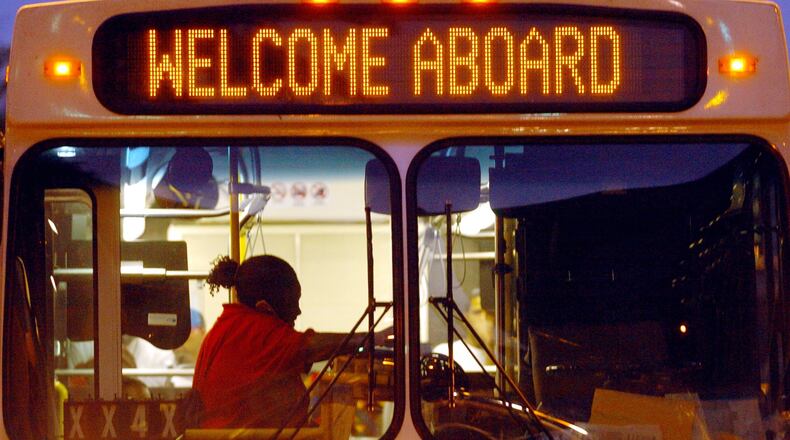Will all or part of Cobb join MARTA, and who gets to decide?
That will depend on whether county commissioners and lawmakers can agree on a map for a proposed special service district, a major sticking point in the negotiations over the regional transit bill currently awaiting Governor Nathan Deal's signature. The version of the bill that passed includes a complicated compromise that could merely put off an inevitable clash.
Cobb Chairman Mike Boyce said right now, “Everything is still on the table.”
“We needed to make sure that Cobb was named somewhere in the legislation to send a message out to the business community, and to others, that we are interested in a regional partnership,” Boyce said. “The language that is now in the legislation allows us to find a way forward to do just that.”
One faction, particularly those officials representing South Cobb and denser areas close to Atlanta, say the county desperately needs fast mass transit to address mobility for residents and economic growth. They point to traffic congestion afflicting all parts of the county, but say they are willing to carve out a special, self-taxing district to contract with MARTA if the rest of Cobb is unwilling to join.
Any special service district map would have to be approved by two separate subcommittees, one comprised of county commissioners, and the other of lawmakers, before it could be adopted by an umbrella committee and placed on the ballot.
Voters residing within the boundaries of a proposed district would need to vote on its creation, funding and the contract for service with MARTA, including a project list, by Dec. 1, 2019.
Representatives from the more rural northern and western parts of the county say their constituents don’t need or want extensive mass transit, but at the same time they don’t want to be left out entirely. They would rather have one transit option with more emphasis on road projects. They also worry that voters living within the special service district would be less likely to support a county-wide transportation SPLOST, cutting off vital roadworks funding for their areas of the county.
Those officials are pressing for an all-or-nothing, county-wide vote on transit, which may or may not include MARTA.
Commissioners and lawmakers are planning to meet over the coming weeks to begin discussions.
“The question is how is this going to be managed, because you’re going to have a lot of cooks in this kitchen,” said State Rep. Teri Anulewicz.
If the referendum fails, Cobb will retain its representation on the new regional transit authority, the ATL, which has the authority to approve regional transit projects.
If officials agree to pursue a special service district for transit, they will also need to propose a funding mechanism, which could include up to a 1 percent sales tax. The amount of revenue raised will have implications for the transit options available.
John Orr, transportation access manager for the Atlanta Regional Commission, cautioned that the transit bill is extremely complex and many variables can influence the cost and feasibility of specific projects. The ARC is currently working on a transit vision for the entire metro area.
The document is advisory only, and does not take into account budgetary restrictions. But, Orr said, it could help inform the regional plan devised by the ATL authority over the coming year.
“It’s basically a compilation of the plans that we’ve worked on with local governments about where they want to pursue transit plans in the future,” he said.
The most intense transit option is heavy rail—what MARTA trains currently run on in Atlanta.
Including right of way, heavy rail averages between $250 and $300 million per linear mile, making it the most expensive option. The advantage is having a dedicated track and faster speeds than light rail.
Light rail, which runs on overhead electricity, is cheaper, at about $150 to $250 million a mile. Light rail can carry fewer people and doesn’t go as fast as heavy rail, but it can run alongside vehicular traffic. Cities including Dallas, Texas and Denver, Colorado have light rail.
Bus Rapid Transit allows large buses to operate in a special lane, with expedited crossing at intersections. When BRT was proposed in Cobb, it won the backing of the business community but provoked an outcry from some residents over the cost and potential impact to traffic. The most recent estimate puts the price tag at about $500 million for roughly 16 miles from Kennesaw to Cumberland.
Arterial Rapid Transit is similar to Bus Rapid Transit, but without expedited passage through intersections. ART is cheaper with a lower level of service than BRT.
Finally, commuter rail places passenger trains on the same railroad track as freight trains and is primarily used to connect outlying communities with the city, like the Amtrak line that runs through Atlanta at Peachtree Station. There has been talk of attempting to use the CSX tracks that run through Marietta for commuter rail, but the depot in Atlanta is not connected to MARTA and coordinating passenger and freight trains on the same track would likely be difficult and expensive.
Boyce expressed skepticism toward the likelihood of rail in Cobb’s immediate future, however, adding that robust bus service may be more realistic.
“The special service district has to be able to fund the project,” Boyce said, pointing out that building new rail would need approval and funding from MARTA and other counties. “What we need to do right now is get started regionally where we connect probably with buses and then if the ATL thinks we need to do a feasibly study to connect us by train, that would be something that they would have to work out with their 16-member body.”
About the Author
Keep Reading
The Latest
Featured




